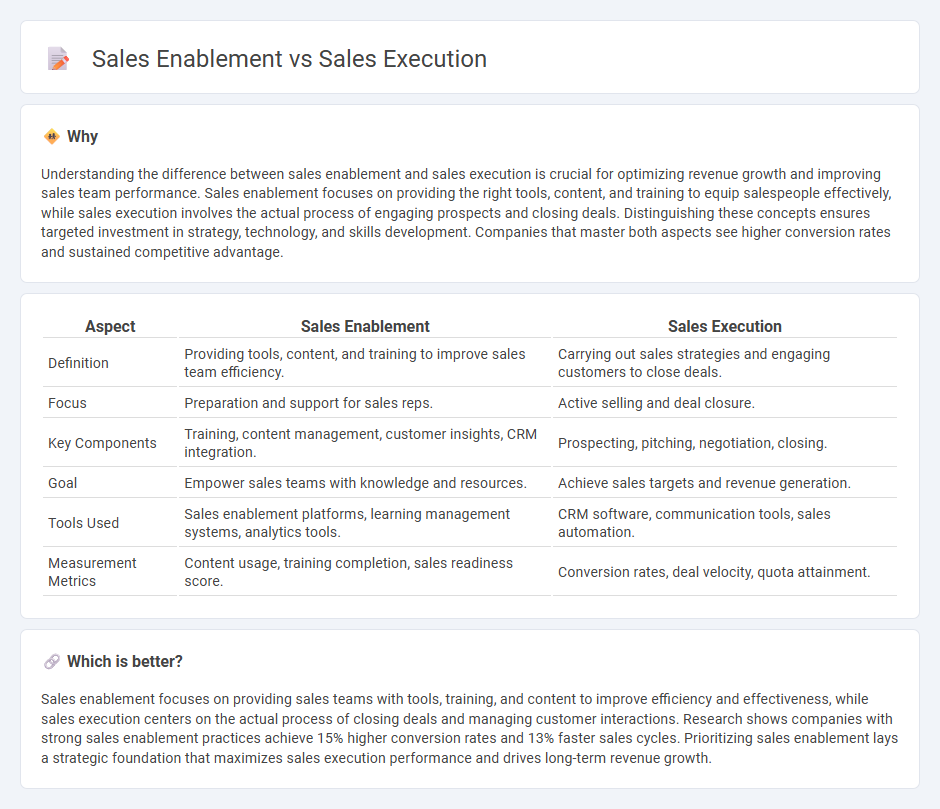
Sales enablement equips sales teams with tools, resources, and training to improve efficiency and effectiveness throughout the sales process. Sales execution focuses on the actual activities and strategies employed to close deals and achieve revenue targets. Discover how aligning sales enablement with execution drives higher performance and business growth.
Why it is important
Understanding the difference between sales enablement and sales execution is crucial for optimizing revenue growth and improving sales team performance. Sales enablement focuses on providing the right tools, content, and training to equip salespeople effectively, while sales execution involves the actual process of engaging prospects and closing deals. Distinguishing these concepts ensures targeted investment in strategy, technology, and skills development. Companies that master both aspects see higher conversion rates and sustained competitive advantage.
Comparison Table
| Aspect | Sales Enablement | Sales Execution |
|---|---|---|
| Definition | Providing tools, content, and training to improve sales team efficiency. | Carrying out sales strategies and engaging customers to close deals. |
| Focus | Preparation and support for sales reps. | Active selling and deal closure. |
| Key Components | Training, content management, customer insights, CRM integration. | Prospecting, pitching, negotiation, closing. |
| Goal | Empower sales teams with knowledge and resources. | Achieve sales targets and revenue generation. |
| Tools Used | Sales enablement platforms, learning management systems, analytics tools. | CRM software, communication tools, sales automation. |
| Measurement Metrics | Content usage, training completion, sales readiness score. | Conversion rates, deal velocity, quota attainment. |
Which is better?
Sales enablement focuses on providing sales teams with tools, training, and content to improve efficiency and effectiveness, while sales execution centers on the actual process of closing deals and managing customer interactions. Research shows companies with strong sales enablement practices achieve 15% higher conversion rates and 13% faster sales cycles. Prioritizing sales enablement lays a strategic foundation that maximizes sales execution performance and drives long-term revenue growth.
Connection
Sales enablement equips sales teams with the tools, content, and training necessary to effectively engage prospects, directly enhancing sales execution by improving communication and closing rates. By aligning sales enablement strategies with sales execution processes, organizations streamline workflows and ensure consistent messaging across all customer interactions. This integration drives higher revenue growth and accelerates the sales cycle.
Key Terms
Sales Process
Sales execution centers on implementing and managing sales activities to drive revenue, ensuring each stage of the sales process--from lead generation to closing--is effectively carried out. Sales enablement focuses on providing sales teams with the tools, content, training, and resources necessary to streamline the sales process and improve buyer engagement. Discover how aligning sales enablement strategies with execution can optimize your sales process for maximum efficiency.
Training
Sales execution centers on applying strategies and techniques to close deals effectively, while sales enablement emphasizes providing ongoing training and resources that equip sales teams with the necessary skills. Training in sales enablement is continuous and tailored to address product knowledge, market trends, and buyer personas, enhancing overall sales performance. Discover how optimizing training programs can bridge the gap between sales enablement and execution for greater revenue growth.
Quota
Sales execution emphasizes achieving and exceeding quota through direct selling activities, pipeline management, and closing deals efficiently. Sales enablement provides the tools, training, and content that empower sales teams to meet quotas consistently by enhancing their knowledge and customer engagement skills. Discover how optimizing both strategies can maximize quota attainment and drive revenue growth.
Source and External Links
What is Sales Execution? - DealHub - Sales execution involves all activities leading to closing a sale, including lead generation, nurturing, and managing customer engagement to meet sales goals effectively through strategic and operational processes.
What is Sales Execution? (and How to Improve Yours) - Mindtickle - Sales execution encompasses an organization's processes for guiding prospects through the sales funnel, emphasizing understanding target audiences and creating tailored strategies to maximize revenue growth.
9 Key Elements of a Sales Execution Strategy - Attention - A successful sales execution strategy should be detailed, process-based, flexible, and include goal setting, deadlines, targeting, pipeline building, and progress tracking to consistently hit sales targets.
 dowidth.com
dowidth.com